 You should know one thing about the fashion of the 19th century: there is no such style. Let us show you the fashion trends of every decade of the 19th century, and you’ll understand what we mean. After reading this article you’ll be familiar with such terms as art nouveau, pagoda sleeves, crinolette, bustle, natural form era, etc. Maybe, we could even surprise you with some of the fashion ideas of the 1900s. And you’ll definitely be able to tell the difference between the fashion of various decades of the 19th century.
You should know one thing about the fashion of the 19th century: there is no such style. Let us show you the fashion trends of every decade of the 19th century, and you’ll understand what we mean. After reading this article you’ll be familiar with such terms as art nouveau, pagoda sleeves, crinolette, bustle, natural form era, etc. Maybe, we could even surprise you with some of the fashion ideas of the 1900s. And you’ll definitely be able to tell the difference between the fashion of various decades of the 19th century.
Today, we’ll show you how to tell different 19th-century fashion decades apart. We’re not going to be talking about what affected fashion but rather what the clothes looked like. Everything in fashion happens gradually so, to understand what was going on at the beginning of a new century, let’s move back a bit to the 1790s.
The 1790s were a transition period. A new slender silhouette came to fashion but it took a while till the ladies got rid of their bum rolls, wigs, and wide petticoats. That’s why in some Jane Austen movie adaptations, you can still see the older generation wearing older 18th-century gowns, while the youngsters are dressed in the empire fashion. So in the 1790s, the waist gradually went higher, the skirts got narrower, the hair smaller (though ladies still used to powder them), turbans and ostrich feathers were the thing. Sleeves were usually elbow length. What’s typical for the era is that the skirts were gathered at the back of the dress, but also at front. That’s why when we look at some of the 1790s fashion plates nowadays all of the ladies look kind of pregnant. Also, if you look at the back of the late 1790s or the early 1800s dress, you can notice a very peculiar cut. The sleeves heads were pushed back towards the shoulder blades and the back of the dress was very short with the shortest point being in the center. Women would even pad this bit of the skirt to make it look fuller. Despite a circulating stereotype, this new silhouette did not make women toss corsets away. Some brave French fashionistas were not wearing them, that’s true, but corsets never completely disappeared. Mainly, because the new silhouette required your bust to basically touch your chin. And what better way to achieve that than some good old push-up bra? We mean, stays.
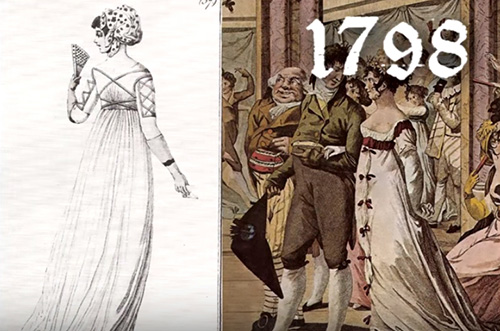
The beginning of the 1800s saw the death of the heavily powdered hair and classicism inspired hairdos became all the range. Women would style their coiffures after antique sculptures and paintings. The dresses also changed. Everyone got crazy about light delicate fabrics. The skirts’ trains were getting longer and longer, the busts were higher than ever, and the bodices were really short.
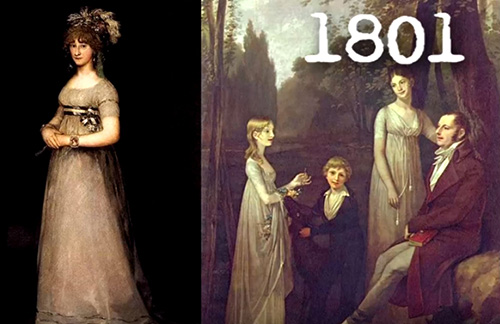
By 1810, the super long trains were no longer in fashion, the skirts got wider and they became more trapezoidal in shape. Rich Indian silks became fashionable. The waist began gradually dropping around 1815. Also, the later in the decade, the more decoration on the everyday outfits. Grecian and Roman Hairstyles were adapted into a very popular look which included curls on both sides of the face together with an intricate updo.
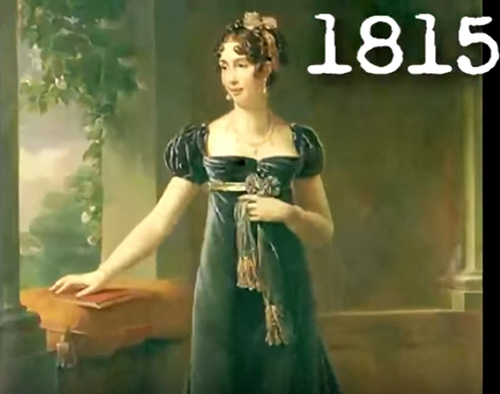
The 1820s were a transitional period from a classical empire silhouette to the crazily over-the-top 1830s. So the skirts got wider and wider, shorter and shorter, the waist drop lower and lower, the sleeves grew bigger and bigger, and more and more decorations started to appear on the dresses. The hem of the skirts was padded to help achieve the trapezoidal shape.

In the 1830s, everything kept growing until the middle of the decade and, let me tell you, got really intense. Women would wear multiple petticoats, some of them stiffened by cording or horsehair to hold the volume of the skirts that were now shorter than ever. They even wore special sleeve supports to make the sleeves bigger. The waist was pretty low at this point but still a bit higher than ladies’ natural waists. Thanks to Queen Victoria who was coronated in 1837, modesty and minimalism came to fashion. From 1836, everything started decreasing: the sleeve puffs started moving downwards, the decoration started disappearing, the skirts were back to floor length, the updos got flat, and in the 1830s, the waist finally reached its natural position.

The 1840s were a decade of earthy colors, fitted pointy bodices, and fitted sleeves, tight collars usually separately attached, and small geometrical patterns. Basically, everything got tighter, and the only thing that kept growing was the width of women’s skirts that required more and more support. The popular hairstyle was a low bun and the middle parting, and that, with some minor modifications, was a hot look up until the late 1860s.
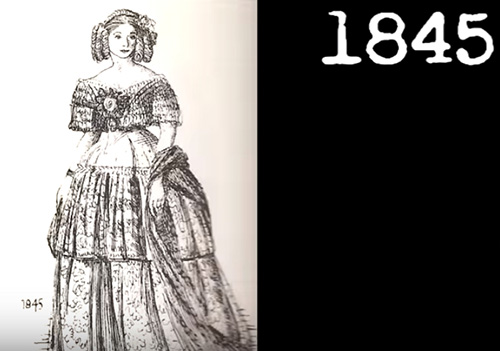
In the 1850s, the problem of growing skirts became so big that it was necessary to develop a special construction to help them stay in shape and not floppy. That construction was called crinoline and it was patented in 1856. Now, note that the crinoline did not exist until then, so if you hear about 18th-century crinolines, that’s absolute nonsense. 18th-century ladies wore hoop skirts or panniers. In the 1850s, skirts were often ruffled which is an easy way to tell them apart from 1840s skirts. Same goes for the sleeves which in the 1850s were wide and called pagoda sleeves. Women would often wear fake white sleeves underneath, so they could peek from the pagoda sleeves. The waist dropped a little bit below the actual waist level and got longer in the front. Plaid dresses were all the range as well as floral motifs.
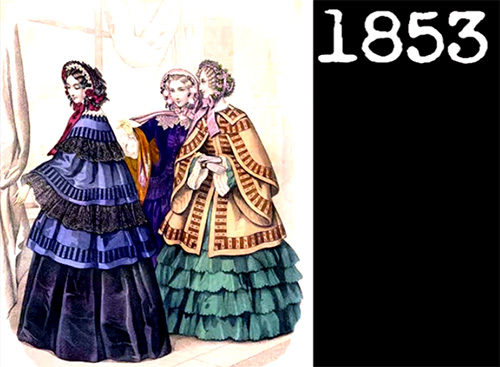
In the 1860s the shape of the whole silhouette started changing. After the waist reached its lowest point in the 1850s, it started going a little bit above the natural waist level in the 1860s. Buttoned bodices became fashionable, the ruffled plaid skirts were gone, and instead plain solid colors were in fashion, with geometrical trimmings, such as the Greek key decorating the hems. The shape of the skirt changed slightly and so did the shape of the crinoline underneath, accentuating the back. Apart from being gathered or pleated at the waist, some skirts were also made of panels. From about 1867, the transitional period started. The waist would start traveling even higher but the skirt this time, instead of expanding or decreasing, would start getting more volume at the back. It would also gradually become more and more decorated. The crinolines gradually morphed into crinolettes and then, around the beginning of the 1870s, into bustles. That’s how we enter the bustle era.
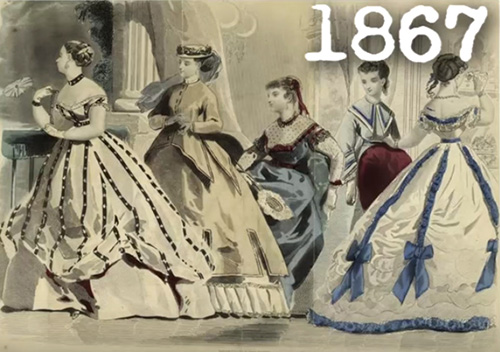
The 1870s were a decade we would compare to the 1830s – big hair, a lot of decorations, frills, flowers, laces, pinks, and pastels. A huge inspiration for the 1870s was 18th-century fashion, and you can kind of tell. Even the hairstyles were sort of Marie Antoinette inspired. Some people would literally take old family dresses from, let’s say the 1780s, and redo them into fashionable creations. Dresses were also influenced by Renaissance and medieval fashions. About the butts – the 1870s bustle was large and the skirt was in trapezoidal shape. To accentuate the silhouette even more, women would wear two skirts: one of them was an underskirt which went – surprise, surprise – under, and the other went on top and was called the overskirt. Overskirts were draped to make the butts look even bigger. And then, suddenly the butts disappeared! Around 1878, women dropped the big bustles and chose to wear small bum pads instead. The skirts got really narrow but, instead of the fullness, the designers came up with length and added long trains. This look called the “natural form era” lasted for only about four years because around 1882, the bustles were back on track! Remember what happened after the 1830s? Minimalism, geometry, earthy tones, strictness – well, this sort of happened after the 1870s, too.

The 1880s are known as the second bustle era and, though at first glance might look similar to the 1870s, there are some significant differences that make it easier to tell them apart. Firstly, the skirts are not the trapezoidal shape anymore. They were just a little bit wider than the hips. Secondly, the shape of the corset changed slightly. Spoon busked corsets came into fashion giving the illusion of a full belly, and we’re not making it up. And from a more harsh geometrical 1870s shape, a curvy wavy 1880s shape developed. Thirdly, the bustles shape or rather angle changed. Instead of gradually going down, the bustles formed a sort of shelf on the lady’s bottoms. Fourthly, ladies’ hairstyles changed. Women would also start cutting their forehead hair and setting it into frizzy bangs. Not the most flattering look, but if you have bangs, this is one of the rare 19th-century fashion history moments when this look is historically accurate.
So as you probably noticed, changes in fashion history usually start with something gradually growing, or decreasing, or getting longer or shorter. So, because skirts kept changing all the time at the beginning of the 1890s, people were like “Hey, what about the sleeves”? Sleeves it is then – from 1890 to around 1895, the sleeves were getting bigger and bigger and bigger, and to balance the huge sleeves the skirts also had to get wider. If you wonder what happened to the bustle, well, it kind of disappeared. The only reminder that the bustle was ever there was a peculiar pleat at the back of the skirts in the early 1890s, but those pleats disappeared after a while, too.

The 1890s were a time where art nouveau was kind of huge, so you can see that in the clothes and the way they’re cut and made. Floral and geometrical designs cover the dresses, jackets, and coats from the era. What is especially lovable about the 1890s is the collars. The coats and capes from the era, jackets, and, generally speaking, outerwear often had very high spiky collars, you know they’re Maleficent kind of collar. The skirts changed once again from trapezoidal wide skirts in the middle of the 1890s to tulip-shaped narrower skirts by the end of the decade. Later in the decade, women also started getting rid of the weird frizzy bangs and a puffy, more art nouveau appropriate, style was introduced. The 1890s were the time of a big discussion around tight lacing, corsets, and how they affect women’s health. Tight lacing wasn’t very popular before but, by the end of the 19th century, more and more fashionistas desired small waists. So the solution to the problem was an invention of an s-bend corset or a health corset in 1900. It completely changed women’s silhouette, but that’s kind of a whole another story.

We hope now, when you hear about something being “Victorian” or “19th-century style”, you know there is no such thing because the 19th century was such a huge piece of fashion history with countless silhouettes, cuts, and styles.
(c)
(c)


